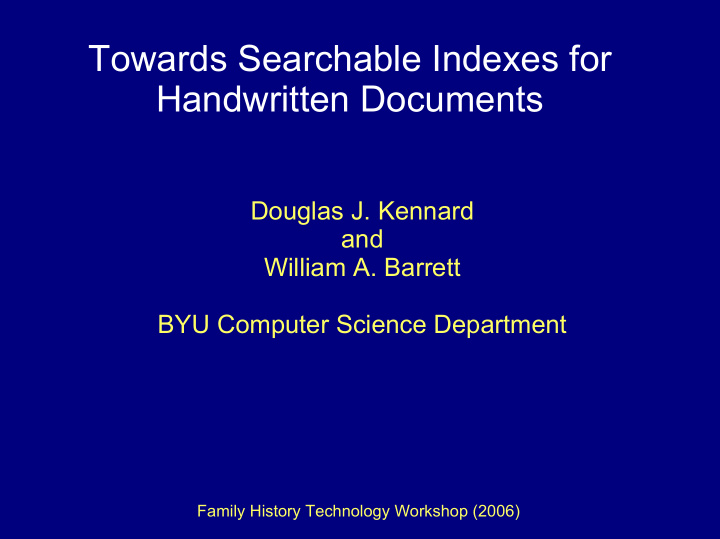



Towards Searchable Indexes for Handwritten Documents Douglas J. Kennard and William A. Barrett BYU Computer Science Department Family History Technology Workshop (2006)
Goal: Ability to “search” handwritten documents Transcriptions are created manually: ● Time-consuming ● Costly
Difficulties in Automatic Handwriting Recognition “Trails of Hope: Overland Diaries and Letters, 1846-1869” (BYU Library online collection)
Difficulties in Automatic Handwriting Recognition inconsistent spacing “Trails of Hope: Overland Diaries and Letters, 1846-1869” (BYU Library online collection)
Difficulties in Automatic Handwriting Recognition Ascenders/Descenders touching other lines of text “Trails of Hope: Overland Diaries and Letters, 1846-1869” (BYU Library online collection)
Difficulties in Automatic Handwriting Recognition No space between words, space within a single word “Trails of Hope: Overland Diaries and Letters, 1846-1869” (BYU Library online collection)
Difficulties in Automatic Handwriting Recognition Same letter shaped differently “Trails of Hope: Overland Diaries and Letters, 1846-1869” (BYU Library online collection)
Difficulties in Automatic Handwriting Recognition Different letters shaped similarly (n, m, r, ...) “Trails of Hope: Overland Diaries and Letters, 1846-1869” (BYU Library online collection)
Difficulties in Automatic Handwriting Recognition Other Problems: Undulating / curved lines Poor penmanship Digitization artifacts / lens distortion Faded ink Smears, blobs, uneven background Deteriorated pages Bleed-through / shine-through Conclusion: Handwriting Recognition is Hard!
A Small Sampling of HR Approaches: Dynamic Programming -Split words into segments -Use DP to match letters to the segments Hidden Markov Models -Hidden states representing “letters of a possible interpretation” -Probability of state transitions producing the observed features Human Reading Models -Top-down and Bottom-up combined -We can't fully segment without some recognition, can't fully recognize without segmentation. Holistic (word-level) Features -Avoid segmenting words (See references in syllabus)
Perfect Transcriptions Aren't Necessary Work done by researchers in France: -Automatic “annotation” -Made Available Online -Users correct errors as they find them
Handwriting Recognition is Still Hard! What are these words? _i_e _on_ (recognition / transcription) five bone live gone time pony dime . . jive . hive . . .
Handwriting Recognition is Still Hard! _i_e _on_ Find the word “lime” (We don't need a transcription, just a “search” for probable matches.)
Excellent Penmanship Relatively “Clean” Images 100 Pages of Training
Our Recent Work Improve Input to HR or Search Systems: -Improve Text Line Segmentation -Mark Ambiguities
Line Segmentation – Simple Profile Method
Line Segmentation – Simple Profile Method
Our Text Line Separation Method -Preprocess -Find Locations of Text Lines -Split / Merge Text Lines -Output Text Line Images
Preprocessing: Background Removal
Preprocessing: Deskew Page
Preprocessing: Choose Threshold Otsu's Method: Threshold too low
Preprocessing: Choose Threshold Good Threshold
Preprocessing: Choose Threshold Threshold too high
Preprocessing: Choose Threshold # Connected Components Threshold Value
Preprocessing: Remove Rule Lines
Find Lines of Text Bitonal (Black / White) Transition Count Map
Find Lines of Text
Find Lines of Text
Find Lines of Text
Find Lines of Text Bitonal (Black / White) Transition Count Map
Find Lines of Text Bitonal (Black / White) Thresholded Transition Count Map
Find Lines of Text Bitonal (Black / White) “Cleaned-Up” Transition Count Map (small components removed)
Split Lines of Text
Split Lines of Text
Split Lines of Text “Min-Cut / Max-Flow” Graph Cut used iteratively to split lines
Merge Spurious Lines of Text
Output Line Images -Expand component region -Ignore outside of expanded region -Anything touching another line component considered ambiguous (within angle constraint)
Output Line Images Grayscale Output Image Output Mask Image
Motivation for Ambiguous component information ? crossing
Planned Future Work Reduce amount of manual training: -Train interactively instead of transcribing (many words get used over and over)
Planned Future Work Reduce amount of manual training: -Train interactively instead of transcribing (many words get used over and over) Example: (from 36 pages of an Overland Trails diary) “and” = 311 times “the” = 286 times 6,212 words total 860 distinct words 86% of the total words are redundant!
Planned Future Work Reduce amount of manual training: -Train interactively instead of transcribing (many words get used over and over) -Sub-word matching (letters and combinations of letters) -Existing methods for generating artificial training data
Conclusions Current Technology permits searching handwritten documents (at least for good quality, large collections) Won't work perfectly. Still very useful– much better than nothing at all! Current and future work will reduce amount of training needed, and improve accuracy by providing better input to the systems.
Questions
Recommend
More recommend